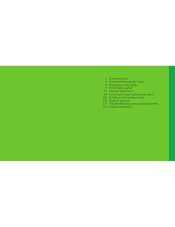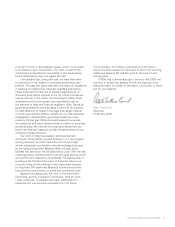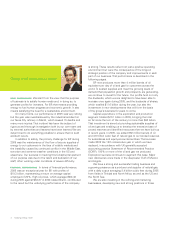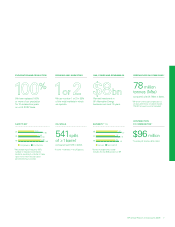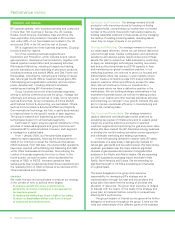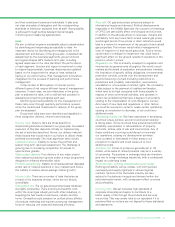BP 2005 Annual Report Download - page 11
Download and view the complete annual report
Please find page 11 of the 2005 BP annual report below. You can navigate through the pages in the report by either clicking on the pages listed below, or by using the keyword search tool below to find specific information within the annual report.
and their constituent teams and individuals. It also sets
out clear principles of delegation and the corresponding
standards of behaviour expected from all staff. Accountability
is achieved through setting detailed internal targets,
monitoring and measuring against plans.
RISKS
We aim to deliver long-term sustainable value to shareholders
by identifying and responding successfully to risks. An
important device for identifying and managing risk is the
development and delivery of the group plan. A detailed risk
assessment by the business segments, group functions
and regions shapes BP’s medium-term plan, including
agreed responses to the risks identified. The performance
of each segment, function and region is monitored in order
to respond appropriately; business objectives are updated
based on the impact that the range of risks realized is
having on our performance. Risk management is therefore
integrated into the process of planning and performance
management.
In the context of BP’s system of internal control,
different types of risk require different types of management
response. In each case, we set milestones in the group
plan to address the risks, with a well-defined process for
assessing and reporting progress each year.
Monitoring and accountability for the management of
these risks occur through quarterly performance reviews,
when the metrics and milestones for delivery of the group
plan are assessed.
Group-level risks have been identified and classified in
three categories: delivery, inherent and enduring.
Delivery risks Delivery risks are those specific to
implementing activities contained in our group plan. Successful
execution of this plan depends critically on implementing
the set of activities described. Hence, our delivery risks are
those factors that would result in our failure to deliver these
activities economically. The most significant risks include:
Upstream renewal Inability to renew the portfolio and
sustain long-term reserves replacement. The challenge is
growing due to increasing competition for access to
opportunities globally.
Major project delivery Poor delivery of any major project
that underpins production growth and/or a major programme
designed to enhance shareholder value.
Portfolio repositioning Inability to complete planned disposals
and/or lack of material positions in new markets (and hence
the inability to capture above-average market growth).
Inherent risks There are a number of risks that arise as
a result of the business climate, which are not directly
controllable.
Competition risk The oil, gas and petrochemicals industries
are highly competitive. There is strong competition, both
within the oil and gas industry and with other industries, in
supplying the fuel needs of commerce, industry and the
home. Competition puts pressure on product prices, affects
oil products marketing and requires continuous management
focus on reducing unit costs and improving efficiency.
Price risk Oil, gas and product prices are subject to
international supply and demand. Political developments
(especially in the Middle East) and the outcome of meetings
of OPEC can particularly affect world supply and oil prices.
In addition to the adverse effect on revenues, margins and
profitability from any future fall in oil and natural gas prices,
a prolonged period of low prices or other indicators would
lead to a review for impairment of the group’s oil and natural
gas properties. This review would reflect management’s
view of long-term oil and natural gas prices. Such a review
could result in a charge for impairment that could have a
significant effect on the group’s results of operations in the
period in which it occurs.
Regulatory risk The oil industry is subject to regulation and
intervention by governments throughout the world in such
matters as the award of exploration and production interests,
the imposition of specific drilling obligations, environmental
protection controls, controls over the development and
decommissioning of a field (including restrictions on
production) and, possibly, nationalization, expropriation,
cancellation or non-renewal of contract rights. The oil industry
is also subject to the payment of royalties and taxation,
which tend to be high compared with those payable in
respect of other commercial activities, and operates in
certain tax jurisdictions that have a degree of uncertainty
relating to the interpretation of, and changes to, tax law.
As a result of new laws and regulations or other factors,
we could be required to curtail or cease certain operations,
causing our production to decrease, or we could incur
additional costs.
Developing country risk We have operations in developing
countries where political, economic and social transition
is taking place. Some countries have experienced political
instability, expropriation or nationalization of property,
civil strife, strikes, acts of war and insurrections. Any of
these conditions occurring could disrupt or terminate
our operations, causing our development activities
to be curtailed or terminated in these areas or our
production to decline and could cause us to incur
additional costs.
Currency risk Crude oil prices are generally set in US
dollars, while sales of refined products may be in a variety
of currencies. Fluctuations in exchange rates can therefore
give rise to foreign exchange exposures, with a consequent
impact on underlying costs.
Economic risk – refining and petrochemicals market
Refining profitability can be volatile, with both periodic
oversupply and supply tightness in various regional
markets. Sectors of the chemicals industry are also
subject to fluctuations in supply and demand within the
petrochemicals market, with consequent effect on prices
and profitability.
Enduring risks We set ourselves high standards of
corporate citizenship and aspire to contribute to a
better quality of life through the products and services
we provide. This may create risks to our reputation if it is
perceived that our actions are not aligned to these standards
and aspirations.
BP Annual Report and Accounts 2005 9



